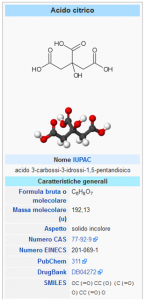 Citric acid is an inhibitor of calcic crystallization and crystalline growth. Therefore, its decrease in urine over normal values may be a risk factor for the formation of calculations. Urinary levels depend on the diet (animal protein) and the acid-base balance; In fact, a hyperprotectal diet may cause a decrease in normal levels of citric acid.
Citric acid is an inhibitor of calcic crystallization and crystalline growth. Therefore, its decrease in urine over normal values may be a risk factor for the formation of calculations. Urinary levels depend on the diet (animal protein) and the acid-base balance; In fact, a hyperprotectal diet may cause a decrease in normal levels of citric acid.
In sperm, instead, citric acid (seminal citric acid) represents a feature index of the prostate, the male gland that produces part of sperm. The values are increased in case of prostate infections and decreased when the prostate has diseases that block the sperm flow. In this last case, before diagnosis, you must also check that the patient has low levels of testosterone.
Principle of the test
Citric acid (citrate) is transformed into oxalacetate and citrate-lysate acetate (CL). In the presence of diseased dehydrogenase (MDH) and lactate dehydrogenase (LDH), oxalacetate and pyruvate, oxalacetate decarboxylation product, are reduced to L-malate and L-lactate, respectively, causing NADH oxidation to NAD + . The formation of NAD + causes a decrease in absorbance at 340 nm.
& Nbsp;
Type of analysis: end point. Reading at 340 nm. Pre-dilution of the sample (diluent provided in the kit).
Ratio R1 / Sample / R2: 40 / 1.2 / 1. Stechiometry of reaction: R1 / Sample / R2: 1000/30/25 ml.
Lyophilic reagent, stable for 1 month after reconstitution if frozen at -20 ° C. Linearity: 24 g / l.
REF: DD11261CM package 5×20 ml, 100 test



 Italiano
Italiano